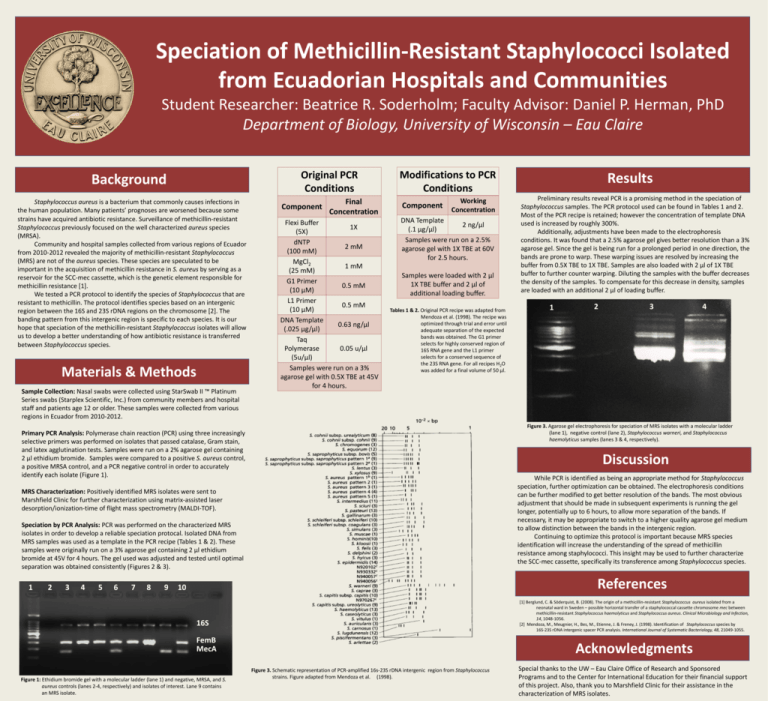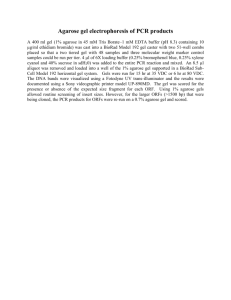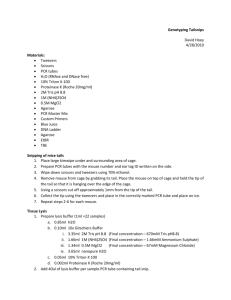SoderholmSpr2013
advertisement

Speciation of Methicillin-Resistant Staphylococci Isolated from Ecuadorian Hospitals and Communities Student Researcher: Beatrice R. Soderholm; Faculty Advisor: Daniel P. Herman, PhD Department of Biology, University of Wisconsin – Eau Claire Original PCR Conditions Background Staphylococcus aureus is a bacterium that commonly causes infections in the human population. Many patients’ prognoses are worsened because some strains have acquired antibiotic resistance. Surveillance of methicillin-resistant Staphylococcus previously focused on the well characterized aureus species (MRSA). Community and hospital samples collected from various regions of Ecuador from 2010-2012 revealed the majority of methicillin-resistant Staphylococcus (MRS) are not of the aureus species. These species are speculated to be important in the acquisition of methicillin resistance in S. aureus by serving as a reservoir for the SCC-mec cassette, which is the genetic element responsible for methicillin resistance [1]. We tested a PCR protocol to identify the species of Staphylococcus that are resistant to methicillin. The protocol identifies species based on an intergenic region between the 16S and 23S rDNA regions on the chromosome [2]. The banding pattern from this intergenic region is specific to each species. It is our hope that speciation of the methicillin-resistant Staphylococcus isolates will allow us to develop a better understanding of how antibiotic resistance is transferred between Staphylococcus species. Materials & Methods Sample Collection: Nasal swabs were collected using StarSwab II ™ Platinum Series swabs (Starplex Scientific, Inc.) from community members and hospital staff and patients age 12 or older. These samples were collected from various regions in Ecuador from 2010-2012. Final Component Concentration Flexi Buffer 1X (5X) dNTP 2 mM (100 mM) MgCl2 1 mM (25 mM) G1 Primer 0.5 mM (10 µM) L1 Primer 0.5 mM (10 µM) DNA Template 0.63 ng/µl (.025 µg/µl) Taq Polymerase 0.05 u/µl (5u/µl) Samples were run on a 3% agarose gel with 0.5X TBE at 45V for 4 hours. Modifications to PCR Conditions Component Working Concentration DNA Template 2 ng/µl (.1 µg/µl) Samples were run on a 2.5% agarose gel with 1X TBE at 60V for 2.5 hours. Samples were loaded with 2 µl 1X TBE buffer and 2 µl of additional loading buffer. Tables 1 & 2. Original PCR recipe was adapted from Mendoza et al. (1998). The recipe was optimized through trial and error until adequate separation of the expected bands was obtained. The G1 primer selects for highly conserved region of 16S RNA gene and the L1 primer selects for a conserved sequence of the 23S RNA gene. For all recipes H2O was added for a final volume of 50 µl. 4 5 6 7 8 9 2 3 4 While PCR is identified as being an appropriate method for Staphylococcus speciation, further optimization can be obtained. The electrophoresis conditions can be further modified to get better resolution of the bands. The most obvious adjustment that should be made in subsequent experiments is running the gel longer, potentially up to 6 hours, to allow more separation of the bands. If necessary, it may be appropriate to switch to a higher quality agarose gel medium to allow distinction between the bands in the intergenic region. Continuing to optimize this protocol is important because MRS species identification will increase the understanding of the spread of methicillin resistance among staphylococci. This insight may be used to further characterize the SCC-mec cassette, specifically its transference among Staphylococcus species. Speciation by PCR Analysis: PCR was performed on the characterized MRS isolates in order to develop a reliable speciation protocal. Isolated DNA from MRS samples was used as a template in the PCR recipe (Tables 1 & 2). These samples were originally run on a 3% agarose gel containing 2 μl ethidium bromide at 45V for 4 hours. The gel used was adjusted and tested until optimal separation was obtained consistently (Figures 2 & 3). 3 1 Discussion MRS Characterization: Positively identified MRS isolates were sent to Marshfield Clinic for further characterization using matrix-assisted laser desorption/ionization-time of flight mass spectrometry (MALDI-TOF). 2 Preliminary results reveal PCR is a promising method in the speciation of Staphylococcus samples. The PCR protocol used can be found in Tables 1 and 2. Most of the PCR recipe is retained; however the concentration of template DNA used is increased by roughly 300%. Additionally, adjustments have been made to the electrophoresis conditions. It was found that a 2.5% agarose gel gives better resolution than a 3% agarose gel. Since the gel is being run for a prolonged period in one direction, the bands are prone to warp. These warping issues are resolved by increasing the buffer from 0.5X TBE to 1X TBE. Samples are also loaded with 2 µl of 1X TBE buffer to further counter warping. Diluting the samples with the buffer decreases the density of the samples. To compensate for this decrease in density, samples are loaded with an additional 2 µl of loading buffer. Figure 3. Agarose gel electrophoresis for speciation of MRS isolates with a molecular ladder (lane 1), negative control (lane 2), Staphylococcus warneri, and Staphylococcus haemolyticus samples (lanes 3 & 4, respectively). Primary PCR Analysis: Polymerase chain reaction (PCR) using three increasingly selective primers was performed on isolates that passed catalase, Gram stain, and latex agglutination tests. Samples were run on a 2% agarose gel containing 2 μl ethidium bromide. Samples were compared to a positive S. aureus control, a positive MRSA control, and a PCR negative control in order to accurately identify each isolate (Figure 1). 1 Results References 10 [1] Berglund, C. & Sӧderquist, B. (2008). The origin of a methicillin-resistant Staphylococcus aureus isolated from a neonatal ward in Sweden – possible horizontal transfer of a staphylococcal cassette chromosome mec between methicillin-resistant Staphylococcus haemolyticus and Staphylococcus aureus. Clinical Microbiology and Infection, 14, 1048-1056. [2] Mendoza, M., Meugnier, H., Bes, M., Etienne, J. & Freney, J. (1998). Identification of Staphylococcus species by 16S-23S rDNA intergenic spacer PCR analysis. International Journal of Systematic Bacteriology, 48, 21049-1055. 16S FemB MecA Figure 1: Ethidium bromide gel with a molecular ladder (lane 1) and negative, MRSA, and S. aureus controls (lanes 2-4, respectively) and isolates of interest. Lane 9 contains an MRS isolate. Acknowledgments Figure 3. Schematic representation of PCR-amplified 16s-23S rDNA intergenic region from Staphylococcus strains. Figure adapted from Mendoza et al. (1998). Special thanks to the UW – Eau Claire Office of Research and Sponsored Programs and to the Center for International Education for their financial support of this project. Also, thank you to Marshfield Clinic for their assistance in the characterization of MRS isolates.







